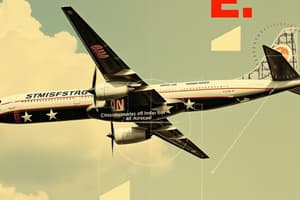Podcast
Questions and Answers
What is Class G airspace?
What is Class G airspace?
Uncontrolled airspace underneath the rest
What are the vertical limits of Class G airspace?
What are the vertical limits of Class G airspace?
From the ground up to 700 FT or 1,200 FT AGL or the floor of other airspaces.
What is the highest Class G airspace can extend to?
What is the highest Class G airspace can extend to?
14,500 FT MSL
What are the requirements to fly in Class G airspace?
What are the requirements to fly in Class G airspace?
What are the night VFR minimums for Class G airspace?
What are the night VFR minimums for Class G airspace?
What are the daylight VFR minimums for Class G airspace below 1,200 FT?
What are the daylight VFR minimums for Class G airspace below 1,200 FT?
Flashcards are hidden until you start studying
Study Notes
Class G Airspace Overview
- Class G airspace is classified as uncontrolled airspace situated beneath other airspace classes.
Vertical Limits
- Extends from the ground up to two elevations:
- 700 feet AGL (Above Ground Level)
- 1,200 feet AGL
- Additionally, it stops at the floor of any overlying controlled airspace.
Maximum Altitude
- The highest permissible altitude for Class G airspace is 14,500 feet MSL (Mean Sea Level).
Flight Requirements
- There are no specific requirements for pilots to operate within Class G airspace.
Night VFR Minimums
- For night visual flight rules (VFR), the minimum visibility requirement is a distance of 3 miles, following the 3/152 rule.
Daylight VFR Minimums Below 1,200 Feet
- Daylight VFR minimums for flights under 1,200 feet are more lenient, requiring visibility of at least 5 miles, adhering to the 5/111 rule.
Studying That Suits You
Use AI to generate personalized quizzes and flashcards to suit your learning preferences.




